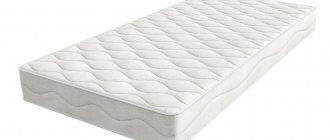A good mattress determines our comfort and proper sleep, therefore, directly affects our well-being, in what state and mood we wake up, how quickly, pleasantly and relaxed we fall asleep. Everyone has their own criteria for comfort; today the market is able to satisfy any needs. Many people believe that if you choose an expensive orthopedic model, it’s like “buy it and forget it.” This is far from true. Any thing requires replacement after a certain time.
For more than 20 years, no mattress can retain its original qualities and characteristics. Any filler ages over time. Orthopedists say that the maximum service life of an orthopedic mattress is 10 years. After this period, it loses its elasticity and is unable to maintain the correct body position during rest. The service life of a children's mattress is 2-3 times lower than products intended for adults. This is due to the fact that it is most often exposed to pollution; small children often jump on it.
What is the service life of mattresses?
Each item has a certain service life, depending on a number of factors. Mattresses are no exception, and therefore require periodic replacement. What is the service life of a particular mattress and how does it depend on the materials used for its production? How often should you change your mattress? There is a direct relationship between these factors that must be taken into account.
Unfortunately, many people sleep on the same mattress for 15-20 years or more. The surface of the product may be heavily dented, so it may simply be unsafe to use.
Note that even the highest quality and most expensive mattresses lose their original characteristics after 10-15 years and require mandatory replacement. On average, experts advise replacing them every 7-8 years, but much depends on the build of people. The fact is that sweat is absorbed into the mattress and particles of dead skin become clogged. This stimulates the development of dust mites, fungi and other harmful microorganisms that provoke the development of eczema, asthma, and allergic reactions.
Average mattress lifespan:
| with soft filling | 4 years |
| spring | 6 years |
| with memory effect | 7 years |
| latex | from 6 to 8 years |
| water | 8 years |
| inflatable | 8 years |
Service life of a mattress with independent springs
Such products have proven themselves well in the market. They are easy to use because the spine takes the correct anatomical shape. The body is resting at this moment. There are several models of similar mattresses:
- System "Duet". The essence of this system is that each spring hides another spring, only smaller. It's like two in one. This is also a very comfortable design that perfectly adapts to the contours of the human body. The service life of the mattress is very long.
- The Multipackage spring block includes about five hundred springs. The mattress can withstand heavy loads, including human weight exceeding 100 g.
- There is also a block called “Micropackage”. This block contains springs of small diameter. The number of springs per square meter varies from a thousand pieces. The mattress is very comfortable and you can relax perfectly on it.
Polyurethane foam mattress
Polyurethane foam filler, if it is not of very good quality, does not last as long as we would like. Service life of a polyurethane foam mattress: maximum three years. After this, you will notice the unpleasant indentations that your body leaves. These mattresses are too soft and do not provide proper body positioning. The spine bends, and this is undesirable. In this case, you should buy a hard mattress, and this will cost more than a spring one.
Foam mattress
In modern terms, foam mattresses are called polyurethane foam. Why did the name change? The fact is that technologies have changed, new materials have appeared, and the quality of the product has improved. What is the difference between foam rubber and polyurethane foam? The chemical formula of both materials is the same, but today it is customary to call a foam mattress a polyurethane foam mattress of the lowest density. They are thin and inexpensive. The service life of a foam mattress is two years; it can last longer, up to six years, given proper use.
Lifespan of a latex mattress
This product is considered the most durable, especially if the latex is natural. The product is resilient and elastic. Indispensable for double beds. The mattress has antibacterial properties and an anatomical effect. The service life of a latex mattress is from fifteen to twenty years.
Coconut mattress
Coconut fiber (or “coir” in other words) often serves as a filler for mattresses. This is an ideal solution for those who suffer from allergies. It is also recommended to buy such mattresses for children. No fungi, mold or other troubles appear in a coconut mattress. It is resistant to moisture and breathable. The service life of a coconut mattress is ten years.
Cotton mattress
Latex
There are two types of latex: natural and artificial. Natural latex is produced by foaming the juice of the giwea, followed by drying at certain temperatures.
The advantages of latex are that it has high breathability, and due to the porous structure of the material, the child’s body does not rot at all. Latex mattresses keep you warm in winter and cool in summer. Also, it will not harbor germs and insects.
For a child of the first three years, it is necessary to purchase a latex mattress with a spring block - this gives it greater rigidity.
When purchasing a latex mattress, do not forget to ask the seller for a product quality certificate, which should indicate the composition of the filler. The use of artificial latex in a children's mattress is possible when the child reaches 3-4 years of age, when it is already clear whether he is predisposed to allergies or not.
How to choose: A good latex product contains about 60% natural rubber. When choosing a latex product, do not hesitate to smell it: if it smells like rubber, it means the latex is synthetic (another name for the artificial material is highly elastic polyurethane foam).
Signs that your mattress needs to be replaced
We've sorted out the service life of spring, orthopedic, springless and other mattresses, but how often do you need to change the mattress on your bed? Based on hygienic reasons, it is recommended to change these products for a comfortable sleep at least every 8-9 years. There are also a number of factors that should encourage you to buy a new bed mattress:
- The last time you changed your mattress was more than 10 years ago. It is unlikely that your body will fully rest on such a bed. Spring and cotton models generally cannot last that long, but it is better not to use springless products after this period.
- You constantly wake up in the middle of the night and are overcome by numbness in parts of your body. You should wake up on your bed rested and full of energy. When an orthopedic mattress loses its elasticity and is pressed through, one can only dream about it.
- You want to constantly put something soft on top of the mattress.
- You have symptoms of asthma, itching, allergies.
- The mattress “creaks” and makes other similar sounds.
- You notice that you get better sleep outside of your home (with friends, family, or in a hotel).
- You constantly wake up in the morning irritated and rush to drink coffee to cheer yourself up. This is a clear sign that the body has not had time to rest and recover due to lack of comfort.
- When examining the mattress, bedsores, bulging springs, or areas of the trim that were gathering in folds were discovered. Such a mattress is unsuitable for future use.
Technologies are gradually developing, and new models of orthopedic mattresses are appearing on the market. The most popular products are those with independent springs and coconut mattresses. You should be able to easily find a suitable model in the store based on price and quality.
Conclusion
The average person spends 26 years of their life sleeping, plus another 7 years trying to fall asleep. It turns out that on average we spend 33 years in bed . But old mattresses not only reduce the benefits of sleep, but also increase the risk of negative consequences for human health.
A mattress is an important component of healthy sleep. There is no need to skimp on it or neglect its replacement.
Was there something you didn’t like about this article, do you have anything to add, or did you find an error? Be sure to write about it. Not a single comment will be left unattended!
What happens if you don't change the mattress?
When a foam, innerspring, or any other mattress reaches the end of its lifespan, you'll want to replace it. We know how often you need to change the mattress on your bed. Otherwise. you will begin to suffer from the following unpleasant factors:
- Allergic and respiratory diseases. Old mattresses harbor microscopic insects, including bed mites, which multiply for years and remain undetected. They cause irreparable harm to people's health.
- Smell. If you haven't changed your mattress in a while, smell it. It is possible that the product will emit an unpleasant odor due to smoldering and rotting of the internal layers under the influence of absorbed moisture.
- Extraneous sounds. When getting out of bed, you may hear an unpleasant characteristic squeak from the mattress on the bed. This indicates deformation of the springs, and the situation can be corrected by replacing the product with a new one.
- Back problems. The main problem that arises when using one mattress for a long time is back pathology. My head starts to hurt. Stiff neck, numb hands. All these signs indicate that the mattress needs urgent replacement.
Why change your mattress? What other compelling arguments are needed for this? According to esotericists, the mattress absorbs various energy debris. It could be negativity that accumulates day after day. You need to get rid of this garbage in order to feel good, at least emotionally. Be attentive to your health and do not forget that it is much cheaper to replace a mattress that has served its useful life than to engage in lengthy and expensive treatment in the future.
How to extend the life of a mattress?
To extend the life of spring and springless mattresses, you can use several simple tricks:
- Buy a mattress protector that fits over the product and protects it from dirt, moisture, dust and water.
- Consider the maximum load on the sleeping place and do not exceed it.
- Constantly ventilate the bedroom, and along with it the mattress.
- Change the bedding on your bed regularly - at least every week, but more often is better.
- Don't let children jump on the bed.
- Clean the mattress periodically using a vacuum cleaner.
- Turn the product over periodically so that its surfaces wear evenly. It is recommended to do this at least once every 1-2 weeks.
- It is not recommended to place a new mattress on a sagging sofa or any other uneven surface. Otherwise, the product will lose all its orthopedic qualities. This effect is manifested when it is correctly placed on a base of lamellas. It is better to give preference to narrow lamellas (three to four centimeters), and the distance between them should be two centimeters, no more. This way there will be no sagging between the spring slats. This is if you have a spring mattress. If the product is without springs, then the width of the lamellas should be 5 cm, as for the distance between them - also 5 cm.
- High temperatures do not have the best effect on your product. The same can be said about exposure to direct sunlight and nearby heaters. Eliminate these factors, and the mattress will last longer than usual.
- The room should not be too humid. Otherwise, hygroscopic fillers will become unusable. The most optimal humidity percentage is 70%.
- It is recommended to clean the product using a vacuum cleaner and a dry soft brush. If you are planning a move, then carefully pack the mattress, and do not twist it under any circumstances.
Now you know how often you need to change your mattress, the dangers of sleeping on a mattress that has expired, and you also know the approximate service life of different products. Remember this information about coconut, spring and springless mattresses, and use it to promptly replace the product to avoid health problems.
Cotton
It’s worth dwelling a little on the cotton mattresses from our childhood. They are now also available in some stores. They are distinguished by their cheapness, but not a wide range of sizes.
Successful arrangement of a sleeping place with such a product is possible, but under a number of conditions.
- First, as noted above, the child’s age is more than three years ;
- Secondly, this sleeping place is not the main one . That is, it can be a crib in a kindergarten, where the child sleeps for 1.5 - 2 hours, or in a country house, where he comes for the weekend.











